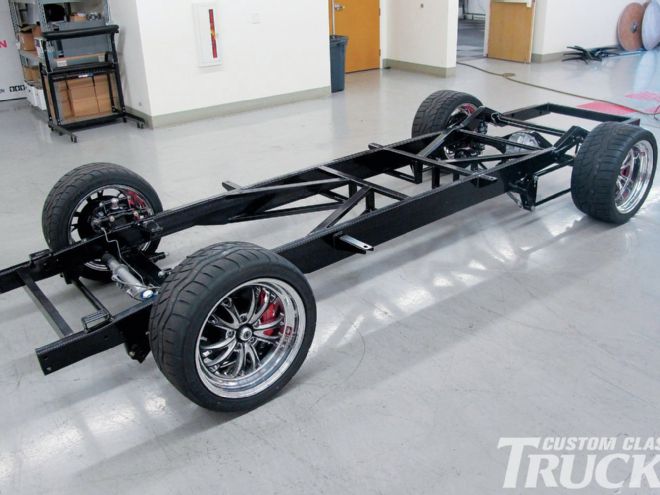
We've been following the construction of Jason Scudellari's Chevy pickup as its come together in the Source Interlink Tech Center and its at the point where much of down and dirty work is done and it's time to start making some things pretty.
Jason's truck has a multi-faceted life ahead of it. Destined to be driven on the street, raced on the track, probably used to chase parts, and most likely have the wheels driven off it, this truck is going to be anything but a pampered show piece. But just because Jason has been concentrating on the pickup's performance potential doesn't mean its appearance isn't important. That's why he has turned his attention to applying a good-looking, durable finish to the frame by having it powdercoated.
Powdercoating has been around for quite some time. Developed in Germany, it was first used in the U.S. during the mid 1960s to cope with problems the Navy was having with protective coatings on helicopter components. At first the application procedure did not lend itself to industrial use, but the elimination of solvents required for conventional coatings, the hazards that came along with spraying them, and tightening government regulations restricting their use and disposal made powercoating more attractive.
By the late 1960s a procedure for applying powder that was similar to the electrostatic application of liquid paint had been developed. The electrically charged powder is attracted to the grounded metal surface that is to be coated. Basically, you can think of powdercoating as paint without solvent. When paint is applied the solvent evaporates and the paint cures. With powdercoating, the charged particles stick to the surface and are cured with heat. When the powder is exposed to the proper temperature (around 390 degrees) it begins to melt, flows out, and then cures. The cure time can vary, but it's normally 10-15 minutes.
Powdercoating has a number of advantages over paint, particularly in applications like this truck frame. More parts can be coated in less time and there are no drips or runs, the cost is lower than liquid coatings, powder is tough and resists chipping from flying debris and dropped wrenches. If there is a downside it can have a certain amount of orange peel when the application is too thin.
Before parts can be powdercoated they must be properly prepared by removing any contaminants such as dirt, grease, rust, welding slag, and so on. While there are a variety of chemical and mechanical methods of accomplishing this, abrasive blasting is the most common. The medias used include: silica sand, aluminum oxide, garnet, glass beads, plastic media, walnut shell, wheat starch, steel grit, and steel shot. Simply put, what is used depends on how hard the contaminants are and the strength of the surface below.
To clean and powdercoat his truck's Fatman frame and components, Jason turned to brothers Gabino and Raul Perez. After working in the industry for 10 years they created the family-owned Millenium Powder Coating. Five years later they run a large-volume production operation with a staff of 20. Known for their ability to carefully and completely strip even delicate sheetmetal and apply smooth, glossy powdercoating they have a loyal following of automotive enthusiasts.
Jason dropped off a trailer-load of stuff, including the frame, rearend housing, and almost all the suspension parts. A short time later all of it was back in the Tech Center and Jason went to work assembling a rolling chassis. Finished in black and with big rubber at all four corners it has a somewhat sinister look. Stick with us as Jason completes his truck, it hits the street and gets tested on the track.
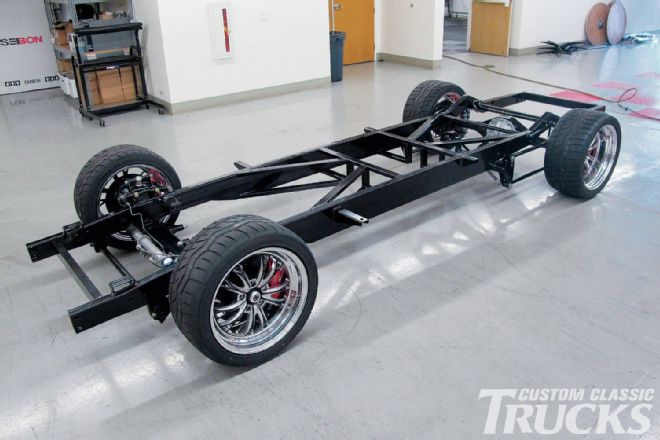 1. Fresh from Millenium Powder Coating, the Fatman Fabrications frame has a tough, durable, and great-looking finish. The chassis rolls on Weld racing wheels and Falken Azenis tires, 275/35/18 front with 315/30/18 in the rear.
1. Fresh from Millenium Powder Coating, the Fatman Fabrications frame has a tough, durable, and great-looking finish. The chassis rolls on Weld racing wheels and Falken Azenis tires, 275/35/18 front with 315/30/18 in the rear.
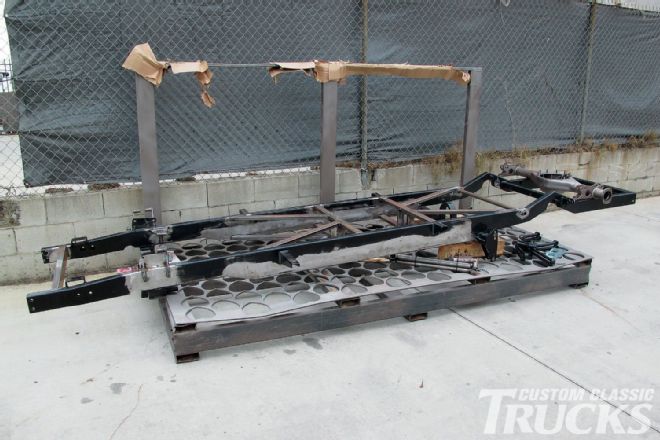 2. Jason Scudellari made a number of modifications to the Fatman frame for his particular needs, so much of the original paint had been ground off. Rather than paint the frame and all the suspension parts he chose powdercoating.
2. Jason Scudellari made a number of modifications to the Fatman frame for his particular needs, so much of the original paint had been ground off. Rather than paint the frame and all the suspension parts he chose powdercoating.
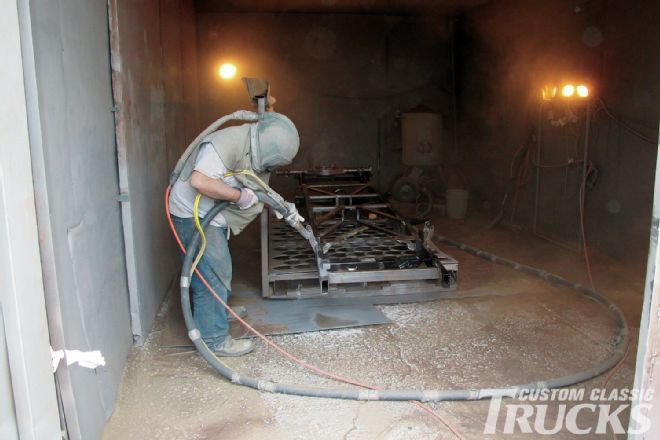 6. In this case the frame is blasted with 80-grit garnet. Experience dictates how much air pressure is used and how close the nozzle is to the piece being blasted.
6. In this case the frame is blasted with 80-grit garnet. Experience dictates how much air pressure is used and how close the nozzle is to the piece being blasted.
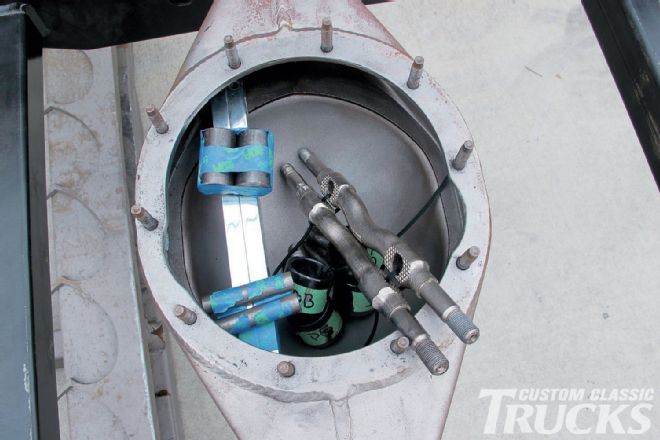 3. Along with the Currie axle housing a number of small suspension parts were coated as well, including the upper A-arm cross-shafts.
3. Along with the Currie axle housing a number of small suspension parts were coated as well, including the upper A-arm cross-shafts.
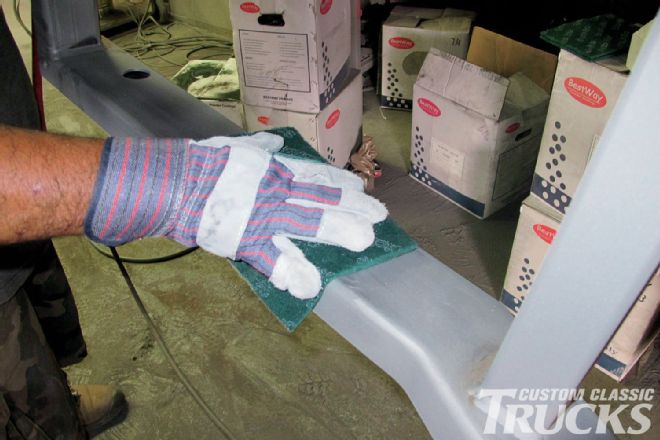 7. To ensure the finish is smooth after blasting an abrasive pad is used to remove any rough spots on the frame.
7. To ensure the finish is smooth after blasting an abrasive pad is used to remove any rough spots on the frame.
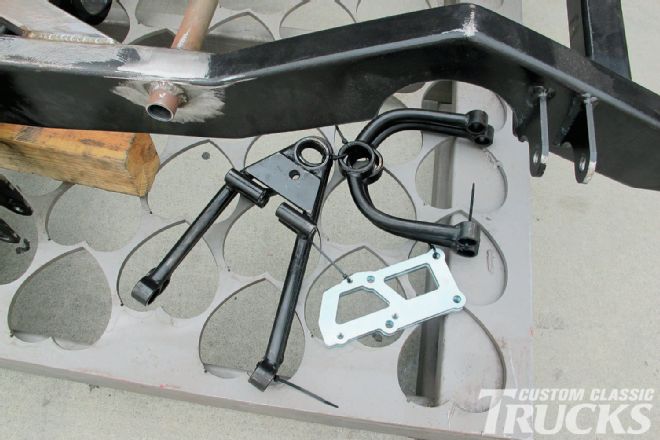 4. Prepping and painting small pieces is time consuming, the more pieces that are powdercoated. From a cost standpoint, the more economical it becomes in comparison to painting.
4. Prepping and painting small pieces is time consuming, the more pieces that are powdercoated. From a cost standpoint, the more economical it becomes in comparison to painting.
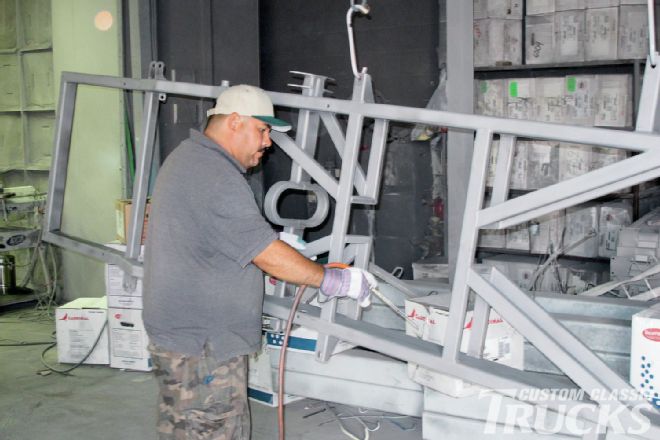 8. The frame and all the parts are blown off with air before the powder is applied.
8. The frame and all the parts are blown off with air before the powder is applied.
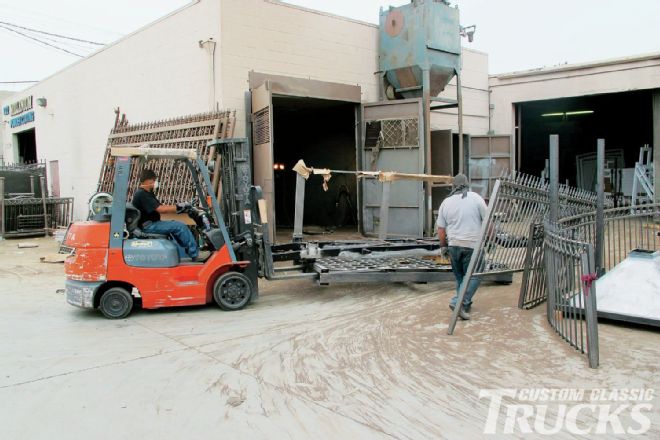 5. The frame is moved into one of the blasting booths—note the huge hopper on the side of the building that holds the blasting media.
5. The frame is moved into one of the blasting booths—note the huge hopper on the side of the building that holds the blasting media.
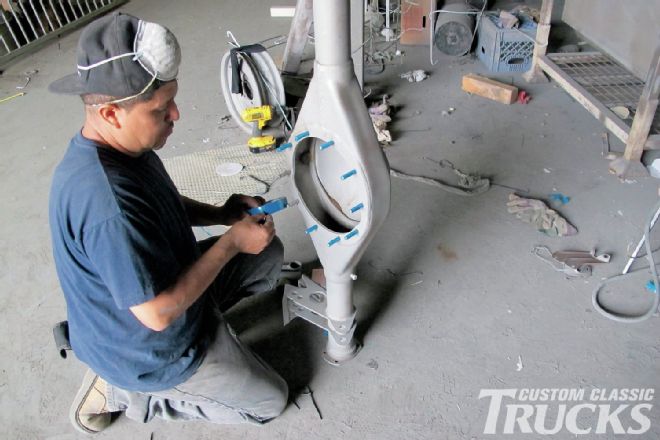 9. Powdercoating can add 1 to 2 mils to the thickness of a surface. Anything with threads or a slip fit has to be protected.
9. Powdercoating can add 1 to 2 mils to the thickness of a surface. Anything with threads or a slip fit has to be protected.
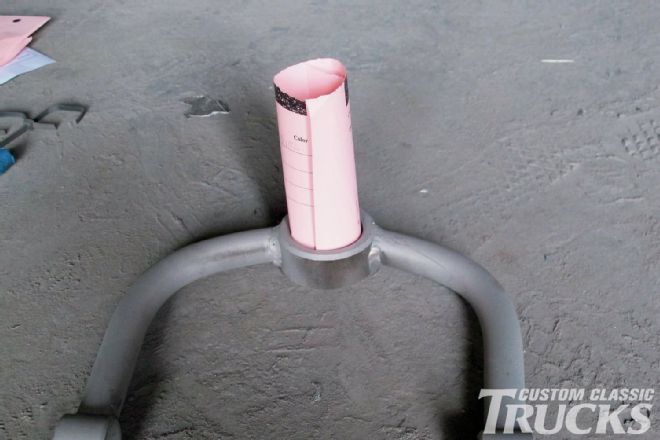 10. The threads in the control arms for the screw-in ball joints were kept powder-free with slips of paper.
10. The threads in the control arms for the screw-in ball joints were kept powder-free with slips of paper.
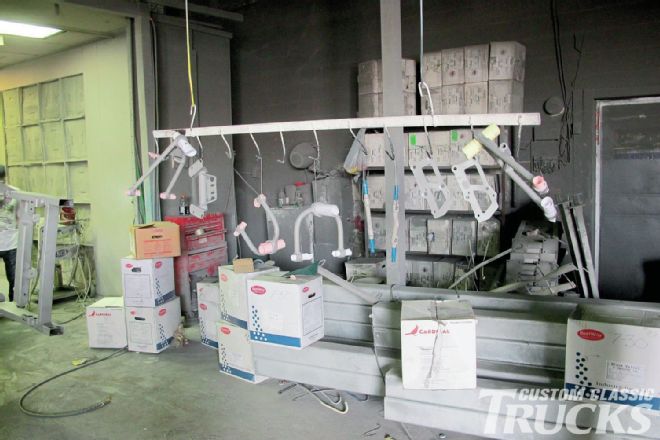 11. All the small parts were hung on a conveyor belt rack that moves into the spray booth.
11. All the small parts were hung on a conveyor belt rack that moves into the spray booth.
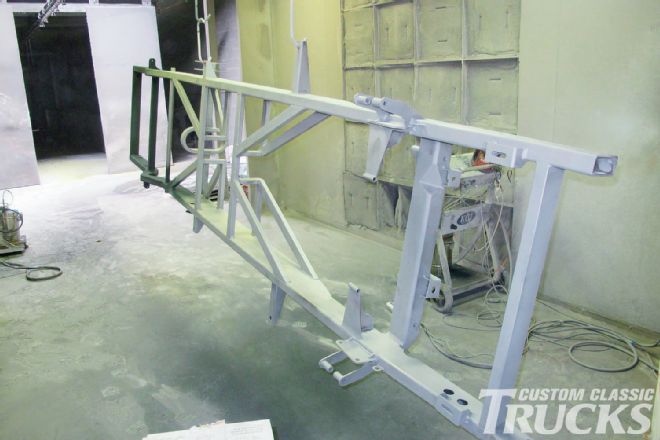 12. Here the frame has been sandblasted, blown off, and is on it’s way into the spray booth by way of the conveyor.
12. Here the frame has been sandblasted, blown off, and is on it’s way into the spray booth by way of the conveyor.
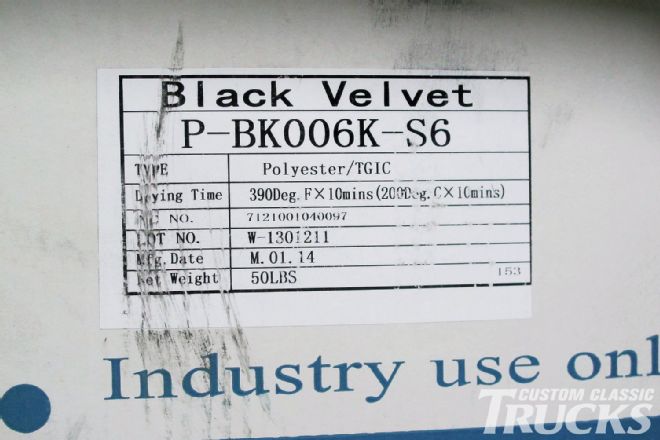 13. Jason’s frame would be coated with black polyester powder that cures at 390 degrees.
13. Jason’s frame would be coated with black polyester powder that cures at 390 degrees.
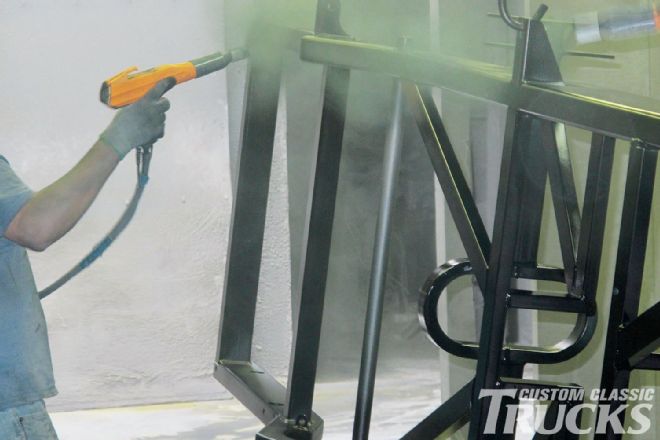 14. The electrically charged powder is applied to the grounded frame. It’s interesting to see the powder get “pulled” toward whatever it’s being applied to.
14. The electrically charged powder is applied to the grounded frame. It’s interesting to see the powder get “pulled” toward whatever it’s being applied to.
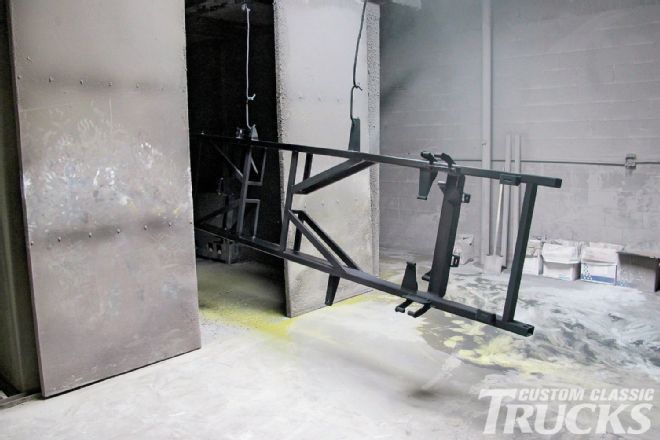 15. After the powder is applied, the conveyor moves the parts into the oven.
15. After the powder is applied, the conveyor moves the parts into the oven.
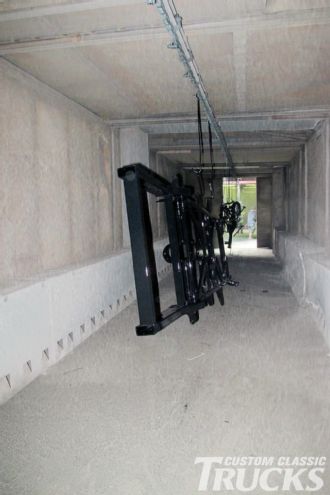 16. During the curing process the conveyor is continually moving thorough the oven—it takes approximately 15 minutes to travel from one end to the other.
16. During the curing process the conveyor is continually moving thorough the oven—it takes approximately 15 minutes to travel from one end to the other.
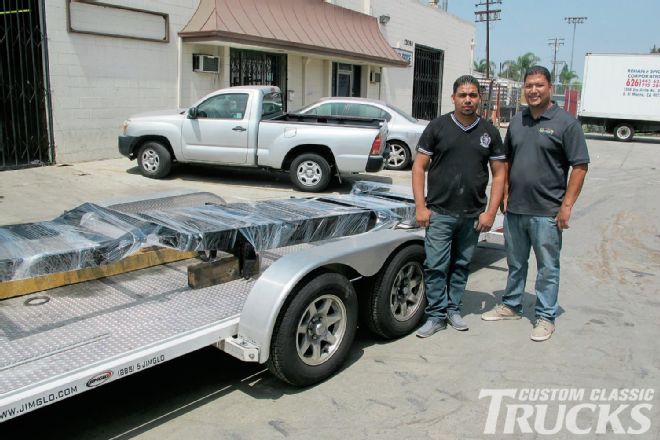 17. Brothers Raul (left) and Gabino Perez run a very busy production shop, but they have also developed an outstanding reputation with the rod, custom, and restoration crowd throughout the southland. Jason’s frame makes it easy to understand why.
17. Brothers Raul (left) and Gabino Perez run a very busy production shop, but they have also developed an outstanding reputation with the rod, custom, and restoration crowd throughout the southland. Jason’s frame makes it easy to understand why.